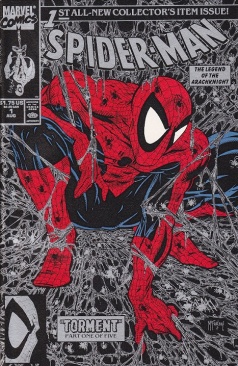Multiversity’s history column is back with an overview of the comic industry circa 1990.
The overall market
In 1990, the direct market was made up of about 1000 individual shops. Although they were vastly outnumbered by newsstand outlets like grocery stores and gas stations, these specialty stores represented almost 85% of comics sold. While the newsstand spinner racks were essential for hooking new customers, fans found comic shops superior in selection, condition, and timing. The selection was better thanks to direct market exclusive titles, but also because of back issues that allowed readers to catch up on stories they missed. The condition of the books was better because the newsstands would stuff comics on the racks without concern for creases, bends, or tears. Meanwhile, comic shops were pushing protective bags and boards, and were extra careful when handling books because mint copies could be sold for more money. The timing was better because comic shops put new books on sale two weeks before the same books could be displayed on newsstands.


McFarlane, Spider-Man, and the way of the future
Todd McFarlane had made a name for himself in the late 1980s as an artist with work on “Incredible Hulk” and “Amazing Spider-Man”, particularly with the introduction of Venom. By 1990, he was ready to try something new, something really different. He told his editor on ASM, Jim Salicrup, that he would like to switch to a book where he would be allowed to write as well as draw. As an untested writer, he didn’t ask for anything specific and expected to be given something low on the totem pole, like “Daredevil” or “Cloak & Dagger”. Instead, Salicrup offered him a brand new Spider-Man book with the option to ignore the continuity of the three existing ones.


At the peak of the anti-comics hysteria in the early 1950s, Frederic Wertham wrote “Seduction of the Innocent”, a populist pillaging of comics filled with anonymous anecdotes and capricious claims. Parents were persuaded, and publishers were panicked. The CCA was formed, and comic content was neutered, reduced to childish stories and losing a generation or two of adult readers. Mature content crept back slowly through code revisions and a direct market accepting of comics without the CCA seal. When the content became questionable once again, former comic store owner John Fulce stood up to defend traditional American values with the 1990 book “Comic Books Exposed: Seduction of the Innocent Revisited”.
This 200-page diatribe criticized comics from a religious point of view and advocated for stricter content restrictions. For someone who used to be a fan, Fulce seems woefully unfamiliar with anything outside of mainstream comics published before 1975. Despite the allusion to Wertham in the title, Fulce never actually references Wertham or anything else from that era of criticism. Calling his book “Seduction of the Innocent Revisited” without actually revisiting Wertham is bizarre. He does share a penchant for strawman arguments and unfounded claims, however.
Fulce’s book failed to fuel public opinion the way Wertham’s did. Perhaps it was his lack of an authoritative title like “psychologist”. Perhaps it was his lack of convincing anecdotes. Perhaps it was because his audience had grown up on comics and turned out fine. Perhaps it was just bad timing, because there were video games and CDs to blame instead of books. Whatever the reason(s) may be, we should all consider ourselves lucky that this book is a footnote of a footnote on comic history instead of a whole chapter.






